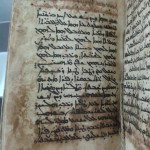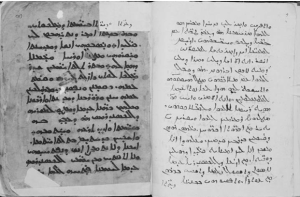Syriac Infancy Gospel of Thomas: Edition in Progress (Part 4)
Back in October and November I wrote a series of three posts (1, 2, and 3) detailing my efforts to construct a critical edition of the Syriac manuscripts of the Infancy Gospel of Thomas. The project is now about eight years (and counting) in the making but it may soon finally see publication because I’ve been working diligently on it over the past six months, to the neglect, unfortunately, of other tasks, such as Apocryphicity. Right now I’m taking a brief pause in the project, so I thought I’d use some of this time to reacquaint myself with the blog by posting a short update.
As previously mentioned, my critical edition will contain three separate recensions of the text:
Sa: based on five manuscripts, two of them from the 6th century; another three interrelated manuscripts from the 17th-18th centuries; and one more from the 15th/16th century that I recently came across that lies midpoint in development between the early and recent manuscripts.
Sw: based on 15 manuscripts (another seven exist in Garshuni, which I am justifiably ignoring) varying from the 15th to the 20th centuries; incorporates IGT into a West Syrian Life of Mary collection in six books (the Infancy of Mary and the Birth of Jesus, both taken from the Protevangelium of James; the Vision of Theophilus; IGT; and the Death of Mary and Departure of Mary from the Dormition of Mary)
Se: three manuscripts of an East Syrian Life of Mary that incorporate IGT (another 13 manuscripts of this text do not include IGT).

In my last post I mentioned coming across new manuscripts of Sa and Sw that had to be incorporated into the what-I-thought-were-completed editions. For Sa, this process did not take very long. One of the two new sources was a copy of one of the more recent manuscripts; so all I had to do there was note in the apparatus where it agreed and disagreed with the other recent manuscripts. The other new source, a manuscript from Mardin, was more of a challenge. Sometimes it agrees with the early manuscripts, sometimes it goes its own way. This is problematic particularly in the places where the two early manuscripts are deficient: how do I choose between the Mardin manuscript and the recent manuscripts? Both diverge from the early tradition. In the end I favoured the recent manuscripts, particularly where they agreed with Sw and/or Se, thus indicating a certain amount of textual stability. That meant that my edition changed little from its original form, but the critical apparatus was significantly augmented.
The situation is similar for Sw (i.e., the edition changed very little), though the three new manuscripts led to considerable rearrangement of the apparatus. First off, the manuscripts were originally arranged in three families: a (ABCD), b (HIJKO), and c (STV). Over the summer, I was able to obtain better images for a manuscript from Cambridge (Add. 2001) already in use in the edition (the microfilm is illegible at points, but the new photographs taken for me by Slavomír Céplö, are crystal-clear). This led me to adopt the Cambridge manuscript as my base text (a subtle shift really, as my first choice for base manuscript was quite similar to the Cambridge manuscript), and forced me to rename the Cambridge manuscript from B to A. Then I discovered that two of the new manuscripts belong to the same family, but are more similar to A and B than C and D; so I changed the names of C and D to E and F and made the new manuscripts C and D. The final new manuscript, Mardin 281, fit quite nicely into the b family as the siglum L, thus leaving the sigla intact. Jean-Daniel Kaestli once told me to never change the sigla once an edition is in progress as it leads to errors. He’s right, of course, but I think the evidence is much more understandable if the relationships between the manuscripts are easily observable in the sigla.

The Sw manuscripts are particularly time-consuming as the contents are often damaged and in disorder. The catalogs typically give few details about the manuscripts; so I feel I should say as much as I reasonably can about them, at least in order to indicate possible relationships between the sources. As mentioned above, IGT generally appears here as book four of a six-book Life of Mary compilation. In a few cases, IGT appears alone (though still retaining the title as “book four”), in another it is missing from the collection, and in another still book three (the Vision of Theophilus) is missing. Frequently the beginning of the first book and the ending of the sixth book have been lost. And several Mary-related memre appear in some of the manuscripts, further indicating relationships between the sources. The challenge for me is to not get too distracted with such issues as the proper ordering of the pages—this is an edition of IGT afterall, not the entire West Syriac Life of Mary. The best I can offer is some preliminary observations about the value of each of the manuscripts, and hopefully someone will use what I have done in future work on the other texts within the collection.
At this point in the project, all three editions are complete, a synopsis has been prepared, the glossary has been augmented with significant readings from the apparati, and I am finishing up the manuscript descriptions. I am also part way through an introduction that provides an overview of previous scholarship. Within a few months this thing should finally be finished.
